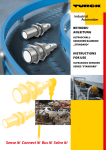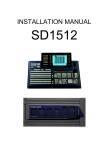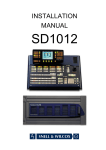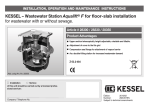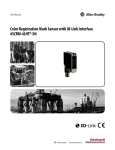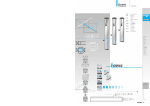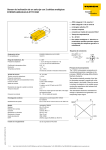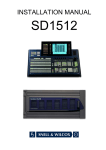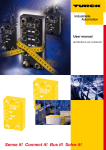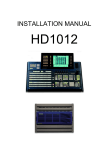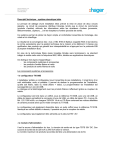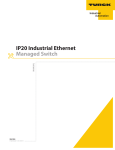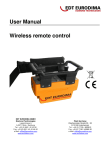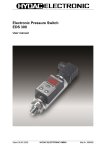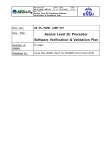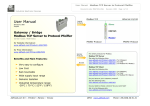Download Inclinometers with IO-link technology
Transcript
InclinoMeters with IO-Link technology Parametrization Sense it! Connect it! Bus it! Solve it! Inclinometers with IO-Link technology – General information 1 General information Please read this section carefully. Safety aspects cannot be left to chance when dealing with electrical equipment. These instructions contain the necessary information for the commissioning and parametrization of the inclinometer series B2N360 from TURCK. It specifically addresses trained and qualified personnel disposing of the appropriate technical knowledge. Prescribed use The devices described in this manual must only be used in the prescribed way and only with certified components and devices from third party manufacturers. Appropriate transport, storage, deployment and mounting as well as careful operating and thorough maintenance guarantee the troublefree and safe operation of these devices. 2 Hans Turck GmbH & Co. KG • Tel. +49 208 4952-0 • Fax +49 208 4952-264 Inclinometers with IO-Link technology – Contents Inclinometers B2N360 – with IO-Link technology [email protected] • www.turck.com • 2013/06 1 General information................................................................ 2 2 Description of the IO-Link technology................................. 4 3 Commissioning and parametrization................................... 5 4 Parametrization via teach function...................................... 6 5 Parametrization via PACTware™ and IODD......................... 7 6 General technical data............................................................. 12 7 Technical data IO-Link............................................................. 13 3 Inclinometers with IO-Link technology – Description of the IO-Link technology 2IO-Link technology An IO-Link system consists of IO-Link devices (sensors or actuators), a standard sensor/ actuator cable and an IO-Link master. An IO-Link master can feature one or several ports. Only one IO-Link device can be connected at each port. IO-Link is therefore a point-to-point communication and not a fieldbus. 2.1.1 SIO mode If the sensor operates in SIO mode it can be run via a standard input module, for which an IO-Link master is not required. Thereby Pin 2 can be used as a switching output, Pin 5 and Pin 6 as analog outputs. Pin 4 is configured as a switching output and can also be used for IO-Link communication. 2.1Operating modes TURCK inclinometers can be operated in SIO mode (standard I/O mode) or in IO-Link communication mode. After power up the device is always in SIO mode. 2.1.2 IO-Link communication mode In order to run the sensor in IO-Link mode, the sensor must be connected to an IO-Link capable module (master). The sensor operates in COM2 mode at 38.4 Kbaud. The IO-Link communication between the sensor and the master is implemented via Pin 4. The output on pin 2 retains its functionality. Process data (cyclic), service data (acyclic) and events are transferred in communication mode. Furthermore, the sensor can be parameterized in communication mode via the master. For detailed information on the sensor parameters see the parameter lists. 4 Hans Turck GmbH & Co. KG • Tel. +49 208 4952-0 • Fax +49 208 4952-264 Inclinometers with IO-Link technology – Commissioning 3 Commissioning For the connection of the inclinometer to the IO-Link master, use the adapter cable RKC 8.4T-1.5-RSC4T/TX320, ident no. 6625002 (sensor side M12, 8-pin, IO-Link master side M12, 4-pin). The ports of the IO-Link master can be configured differently. If a port is set to SIO mode, the master at this port behaves like a normal digital input. If the port is set to communication mode, it tries to find the connected sensor. This process is called the wake up process. For this read also the manual for your IO-Link master. If the sensor is in IO-Link mode, it can be parameterized via the master. For this read chapter 7 Parametrization using PACTware™ and IODD PACTware™ is an open platform in which any fieldbus device manufacturer can integrate the operation of their devices. PACTware™ uses a standard interface between the frame program and the individual software modules for operating devices. Only in this way can modern user-friendly operating concepts be implemented. Parametrization using the teach function The inclinometer can be set via the teach function. Pin 8 is used as teach input, whereby the inclinometer is parametrized by bridging Pin 8 and Pin 3 (GND) or Pin 8 and Pin 1 (UB). For simple teaching use the optionally available teach adapter TX3-Q20L60 with the ident no. 6967118. With the switches you can activate the teach inputs. The connection between the sensor and PC is established via the USB-IO-Link master. In order to operate the Turck inclinometer via PACTware™, you also need the IODD interpreter and sensor-specific IODD in addition to the PACTware™ software. These tools can be obtained from the TURCK website. The standard display of PACTware™ enables the sensor to be read and set easily. For more details and specific parameter information see the parameter lists. More information about the PACTware™ software is provided at www.turck.com. [email protected] • www.turck.com • 2013/06 5 Inclinometers with IO-Link technology – Parametrization via teach function 4Parametrization via teach function Parameters Teach input LED To adjust the zero point offset and the measuring range, position the sensor accordingly. Zero point offset (see notes on p. 7) bridge Pin 3 (GND) and Pin 8 for 5 s yellow LED flashes – after 1 s steady – after 3 s flashes – after 5 s steady Measuring range start, x-axis (see notes on page 7) bridge Pin 1 (UB) and Pin 8 for 1 s green LED flashes – after 1 s steady Measuring range end, x-axis (see notes on page 7) bridge Pin 1 (UB) and Pin 8 for 3 s green LED flashes – after 1 s steady – after 3 s flashes Measuring range start, y-axis (see notes on page 7) bridge Pin 3 (GND) and Pin 8 for 1 s yellow LED flashes – after 1 s steady – after 3 s flashes Measuring range end, y-axis (see notes on page 7) bridge Pin 3 (GND) and Pin 8 for 3 s yellow LED flashes – after 1 s steady – after 3 s flashes Preset mode Preset angular ranges bridge Pin 1 (UB) and Pin 8 for 10 s bridge or press the button within 10 s or the device exits this mode automatically green LED flashes – after 10 s steady -10°…+10° bridge Pin 3 (GND) and Pin 8 once briefly yellow LED flashes once -45°…+45° bridge Pin 3 (GND) and Pin 8 twice briefly yellow LED flashes twice -60°…+60° bridge Pin 3 (GND) and Pin 8 three times briefly yellow LED flashes three times -85°… +85° bridge Pin 3 (GND) and Pin 8 four times briefly yellow LED flashes four times Preset mode Functions bridge Pin 1 (UB) and Pin 8 for 10 s bridge or press the button within 10 s or the device exits this mode automatically green LED steady – after 10 s flashes Mode 1 "upper hemisphere" ± 90°, default setting bridge Pin 1 (UB) and Pin 8 once briefly green LED flashes once Mode 2 "lower hemisphere" ± 90° bridge Pin 1 (UB) and Pin 8 twice briefly green LED flashes twice Mode 3, 2 × 360° bridge Pin 1 (UB) and Pin 8 three times briefly green LED flashes three times Mode 4, X: 0…360°, Y: off bridge Pin 1 (UB) and Pin 8 four times briefly green LED flashes four times Mode 5, Y: 0…360°, X: off bridge Pin 1 (UB) and Pin 8 five times briefly green LED flashes five times Filter setting mode bridge Pin 3 (GND) and Pin 8 for 10 s bridge or press the button within 10 s or the device exits this mode automatically yellow LED steady – after 10 s flashes Filter A, 24 Hz (for programming adapter Q20L60), default setting bridge Pin 3 (GND) and Pin 8 once briefly yellow LED flashes once Filter B, 15 Hz bridge Pin 3 (GND) and Pin 8 twice briefly yellow LED flashes twice Filter C, slower but less susceptible Filter bridge Pin 3 (GND) and Pin 8 three times briefly yellow LED flashes three times Default setting bridge Pin 3 (GND) or Pin 1 (UB) and Pin 8 for 15 s after 15 s yellow and green LED alternate fast 6 Hans Turck GmbH & Co. KG • Tel. +49 208 4952-0 • Fax +49 208 4952-264 Inclinometers with IO-Link technology – Parametrization via PACTware™ and IODD NOTE Please note that with changing the zero point you also change the start and end point of the measuring range accordingly. In the "upper hemisphere" and "lower hemisphere" mode the zero-point can only be offset if the measuring range stays within the defined spreads of 0°…90°, 0°…270°, 180°…90° or rather 180°…270° (see Fig. 2, on page 8). 5Parametrization via PACTware™ and IODD You can download PACTware™, the IODDinterpreter and the inclinometer IODD-file from www.turck.com. Once you have installed PACTware™, activate the "IODD_IOL_B2N360-Q42.zip" file with the IODD-interpreter and update the device catalog in PACTware™. You need the following hardware components: ■■B2N360-Q42… (the sensor to be parametrized) ■■IO-Link master ■■Adapter cable RKC8.4T-1,5-RSC4T/TX320; Ident no.: 6625002 Depending on the application requirements, you should parametrize and test the appropriate filter setting using PACTware™. Three filter settings can be specified (Filter A, B, C). For each of these settings you can choose from over 30 different filter values. Under the menu item "Active filter" you can finally select the active filter setting. These three filter settings (Filter A, B, C) can also be set via teach function (see previous page 6) without IO-Link communication. 5.1 Configure system Under the menu item "Operation Mode" you can either configure the sensor as an inclinometer or as accelerometer (see also page 11). You can set different lowpass filters. Faults of different frequency ranges can thus be suppressed. [email protected] • www.turck.com • 2013/06 7 Inclinometers with IO-Link technology – Parametrization via PACTware™ and IODD 5.2 Configure angle Under the menu item "Mounting position" you can adapt the sensor to the respective application. In default status (upper hemisphere) the sensor provides output values in the tilt position of 5 V or 12 mA as the zero point for the X and the Y axis. All six possible mounting positions can be configured with this output behaviour. For example, if the connector should face upwards, this can be set under this menu item. The menu item "Functional area" provides five possible functions (see also programming via teach function, page 6): The factory default assignment of the axes is shown in the following figure: Upper and lower hemisphere are defined as follows 1 Upper hemisphere (see fig. 2) 2 Lower hemisphere (see fig. 2) 3 (2 × 360°) 4 (360° X) 5 (360° Y) 2 Lower hemisphere The sensor provides the possibility to capture all angles from 180°…90° or rather 180°…270° via the X and the Y-axis. 0° -90 270° Y 90° X 180° Fig. 1: Assignment of axes 1 Upper hemisphere This function is the default setting. The sensor provides the possibility to capture all angles from 0°…±90° via the X and the Y-axis. NOTE: In PACTware™ , angles are specified as absolute values between 0°…359.99°. Entering negative areas is therefore not possible. The following are the standard measuring ranges: ±45° = 315°…45° ±60° = 300°…60° ±30° = 330°…30° ±10° = 350°…10° Fig. 2: Definition of the upper and lower hemisphere 3 (2 x 360°) The sensor captures the entire angular range of 0°…360° via the X and the Y-axis. Please observe, however, that owing to the principle involved, the analog output signals may mutually influence each other. 4 (360° X) The X-axis is output over the entire range (0°…360°). The Y-axis is turned off. 5 (360° Y) The Y-axis is output over the entire range (0°…360°). The X-axis is turned off. 8 Hans Turck GmbH & Co. KG • Tel. +49 208 4952-0 • Fax +49 208 4952-264 Inclinometers with IO-Link technology – Parametrization via PACTware™ and IODD 5.3 Configure analog outputs Use the menu item "Output type" to define the analog output either as current or voltage output. "Start value" or "End value" are the limit values of the analog output. These can be chosen freely between 0 mA and 20 mA or 0 V and 10 V. It is also possible for example to select an output range of 0…10 mA. In the menu item "Overrange behaviour" you determine how the sensor behaves in case of exceeding the set measuring range. You can adjust that the limiting value is either held or that an error beep is issued. [email protected] • www.turck.com • 2013/06 In the menu item "Direction of rotation" you can select between "clockwise CW" and "counterclockwise CCW" rotation. The "Lower limit" and "Upper limit" of the measuring range define the active area of the sensor. For instance, if you want to parameterize a detection range of ±30°, here you can set 330° (lower limit) and 30° (upper limit) in "clockwise direction of rotation. If the sensor is mounted on a flat surface where the slope is used as the zero point (5 V or 12 mA), this can be done by selecting the menu item "Zero point offset teach". To enter values for movement of the zero point select the menu item "Zero point offset" (see also teach function page 6). You can also use the current tilt position of the sensor for the upper and lower limit. You can make these settings in the menu item "Teach start position of measuring range" resp. "Teach end position of measuring range (see also teach function on page 6). 9 Inclinometers with IO-Link technology – Parametrization via PACTware™ and IODD 5.4 Configure digital outputs Pin 2 and pin 4 of the inclinometer can be used as a switching output. The switchpoint and the hysteresis are defined as follows under "Digital Outputs" as output 1 (Pin 2) and output 2 (Pin 4). In "Referring axis" you specify which axis (X or Y) is used for the determination of the switchpoint. 10 In "Output type" you can select between PNP and NPN switching function. In "Teach switchpoint ON" and "Teach switchpoint OFF", the current inclined positions are taken to define the hysteresis. In addition, you can parametrize a "hysteresis" (0.01° or greater) for the switchpoints or select the switching behaviour in the menu item "Inverting". In "Switchpoint ON" or rather "Switchpoint OFF" you enter the angular range for the hysteresis in plain text. Hans Turck GmbH & Co. KG • Tel. +49 208 4952-0 • Fax +49 208 4952-264 Inclinometers with IO-Link technology – Parametrization via PACTware™ and IODD 5.5 Configure "acceleration" The operating modes "Inclination" and "Acceleration" are selected in the system configuration (see also page 7). In the selection "Acceleration X/Y linear" the acceleration is output as an analog signal separately in the X and Y-direction. The detectable acceleration values are ±2 g, with the initial value being 0 V or rather 0 mA with -2 g, 5 V or rather 10 mA, with 0 g and 10 V or rather 20 mA with 2 g. The following top view Fig. 3 shows the corresponding acceleration: In the operating mode "Acceleration 2D" or "Acceleration 3D" the sensor uses the analog output (Pin 5). The direction of the acceleration is not taken into account, only the value is issued. Fig. 4 shows the corresponding acceleration "2D"; Fig. 5 for "3D". The following values can be determined 0 g = 0 V or rather 0 mA to 2 g = 10 V or rather 20 mA. In addition, a switching output can be defined as threshold logic, i.e. if the freely selectable threshold value is exceeded, the output switches through for at least 1 second. Fig. 4: Directions of acceleration 2D (top view) x y Fig. 5: Directions of acceleration 3D (top view) Fig. 3: Directions of acceleration X/Y linear (top view) [email protected] • www.turck.com • 2013/06 11 Inclinometers with IO-Link technology – Technical data 6Technical data 42,5 42,5 ø 5,3 LED M12 x 1 52 22,85 2 67,7 Measuring range specifications Measuring range Measuring range x-axis Measuring range y-axis Wiring diagram 0…360° 0…360° 0…360° System Resolution Repeatability/accurancy Linearity deviation Temperature drift Ambient temperature 16 bit ≤ 0.03 %, depending on filter setting ≤ 0.2 % of full scale ≤ ± 0.015 % / K B2N360-Q42-E2LiUPN8X2-H1181: -25…+70 °C B2N360-Q42-E2LiUPN8X2-H1181/S97: -40…+70 °C Electrical data Operating voltage Residual ripple DC rated operational current Rated insulation voltage Short-circuit protection Wire breakage/reverse polarity protection Output function Voltage output Current output Load resistance voltage output Load resistance current output Sampling rate 1 2 3 4 5 6 7 8 UB out GND out/IO-Link X-out Y-out n.c. teach B2N360-Q42-E2LiUPN8X2-H1181: 15…30 VDC B2N360-Q42-E2LiUPN8X2-H1181/S97: 7…30 VDC ≤ 10 % Upp ≤ 150 mA ≤ 0.5 kV yes yes/entirely 8-wire, NO/NC , PNP/NPN, analog output 0…10 V 4…20 mA parametrizable via IO-Link, e.g. 0…20 mA ï 4.7 kW ≤ 0.4 kW 500 Hz Housing Housing style Dimensions Housing material Connection Vibration resistance Shock resistance Protection class (IEC 60529/EN 60529) MTTF rectangular, Q42 67.5 × 42.5 × 42.5 mm plastic, PA 12-GF30 male, M12 × 1 55 Hz (1 mm) 30 g (11 ms) IP68/IP69K 159 years acc. to SN 29500 (Ed. 99) 40 °C LED indication Power-on indication Switching status 12 1 × LED green 1 × LED yellow Hans Turck GmbH & Co. KG • Tel. +49 208 4952-0 • Fax +49 208 4952-264 Inclinometers with IO-Link technology – Technical data IO-Link 7IO-Link – Technical data Physics Physics 2 (3-Wire) Com-Type Standard: COM 2 (38400 Baud) Frametype Frametype 2.2 7.1 Parameter data You can read and write to the sensor via the IO-Link parameter dataset. 7.1.1 System parameters (System Command) Restarting the communication. Index (hex.) Index (dez.) R/W Function 0x02 2 W 1: restart 7.2.2 Identification The following parameters can be read out: ■■Manufacturer's name ■■Manufacturer text ■■Product name ■■Product ID ■■Product text ■■Serial number ■■Hardware version ■■Firmware version The following parameter can be read out and set: ■■Specific name of the application Index (hex.) Index (dez.) R/W Function 0x10 16 R Manufacturer's name 0x11 17 R Manufacturer text 0x12 18 R Product name 0x13 19 R Product ID 0x14 20 R Product text 0x15 21 R Serial number 0x16 22 R Hardware version 0x17 23 R Firmware version 0x18 24 R/W Specific name of the application [email protected] • www.turck.com • 2013/06 13 Inclinometers with IO-Link technology – Technical data I/O-Link 7.1.3 Analog process data Here, you can read out the angle in X-direction and Y-direction. Index (hex.) Index (dez.) R/W Function 0x40 64 R Measuring angle X 0x41 65 R Measuring angle Y 7.1.4 Teach in The following teachable parameters can be read or written. Index (hex.) Index (dez.) R/W Function 0x70 112 R/W Operation 1: Inclination/(2: Vibration)/3: Acceleration XY/4: Acceleration 2D 0x71 113 R/W Lowpass filter A, 0…30, 255: Disabled 0x72 114 R/W Lowpass filter B, 0…30, 255: Disabled 0x73 115 R/W Lowpass filter C, 0…30, 255: Disabled 0x74 116 R/W Active filter: 1…3 0x75 117 R/W Angle compensation 0 OFF; 1 ON 0x80 128 R/W Configuration analog output X, 1: I/2: U 0x81 129 R/W Configuration analog output X, "Start value" in mV / 0.001 mA 0x82 130 R/W Configuration analog output X, "End value" in mV / 0.001 mA 0x83 131 R/W Overrange behaviour X 1: End value/2: error beep 0x84 132 R/W Configuration analog output X, rotation direction 1: CW/2: CCW 0x85 133 R/W Start position measuring range X entry in ° × 100, defined between 0…36000 0x86 134 W Start position measuring range X measurement of current angle, 1: Recording of measured value 0x87 135 R/W End position measuring range X entry in ° × 100, defined between 0…36000 0x88 136 W End position measuring range X measurement of current angle, 0x89 137 R/W Zero point reference X entry in ° × 100, defined between 0…36000 0x8A 138 W Zero point reference X measurement of current angle, 0x8B 139 R/W Zero point reference acceleration XY: X entry 0x8C 140 W Zero point reference acceleration XY: X measurement of current value, 1: Recording of measured value 1: Recording the measured value 1: Recording of measured value 0x8D 141 W Zero point reference acceleration XY X, 1: Reset 0x90 144 R/W Configuration analog output Y, 1: I/2: U 0x91 145 R/W Configuration analog output Y, "Start value" in mV / 0.001 mA 0x92 146 R/W Configuration analog output Y, "End value" in mV / 0.001 mA 0x93 147 R/W Overrange behaviour X 1: End value/2: error beep 0x94 148 R/W Configuration analog output Y, rotation direction 1: CW/2: CCW 0x95 149 R/W Start position measuring range Y entry in ° × 100, defined between 0…36000 0x96 150 W Start position measuring range Y measurement of current angle, 1: Recording of measured value 0x97 151 R/W End position measuring range Y entry in ° × 100, defined between 0…36000 0x98 152 W End position measuring range Y measurement of current angle, 1: Recording of measured value 14 Hans Turck GmbH & Co. KG • Tel. +49 208 4952-0 • Fax +49 208 4952-264 Inclinometers with IO-Link technology – Technical data I/O-Link continued on next page Index (hex.) Index (dez.) R/W Function 0xA0 160 R/W Switching output 1 axis, 1: X/2: Y 0xA1 161 R/W Switching output 1 type NPN/PNP, 1: PNP/2: NPN 0xA2 162 R/W Switching output 1 ON entry in ° × 100, defined between 0…36000 0xA3 163 W Switching output 1 ON measurement of current angle, 1: Recording of measured value 0xA4 164 R/W Switching output 1 OFF entry in ° × 100, defined between 0…36000 0xA5 165 W Switching output 1 OFF measurement of current angle, 1: Recording of measured value 0xA6 166 R/W Switching output 1, hysteresis in ° × 100, defined between 0…36000 0xA7 167 R/W Switching output 1, inversion of switching range 0xA8 168 R/W Switching output 1, enter threshold 0 …2000 mg, acceleration XY, X-direction 0xA9 169 R/W Switching output 1, enter threshold 0 …2000 mg, acceleration 2D 0xAA 170 R/W Switching output 1, enter threshold 0 …2000 mg, acceleration 3D 0xB0 176 R/W Switching output 2 axis, 1: X/2: Y 0xB1 177 R/W Switching output 2 type NPN/PNP, 1: PNP/2: NPN 0xB2 178 R/W Switching output 2 ON entry in ° × 100, defined between 0…36000 0xB3 179 W Switching output 2 ON measurement of current angle, 1: Recording of measured value 0xB4 180 R/W Switching output 2 OFF entry in ° × 100, defined between 0…36000 0xB5 181 W Switching output 2 OFF measurement of current angle, 1: Recording of measured value 0xB6 182 R/W Switching output 2, hysteresis in ° × 100, defined between 0…36000 0xB7 183 R/W Switching output 2, inversion of switching range 0xB8 184 R/W Switching output 1, enter threshold 0 …2000 mg, acceleration XY, Y-direction 0xC0 192 R/W Selection of the functions 1: upper hemisphere; 2: lower hemisphere; 3: 2 × 360°; 4: 360° X; 5: 360° Y 0xC1 193 R/W Mounting position,1: Normal; 2: 90° Y; 3: 180°; 4: 270° Y;5: 90° X; 6: 270° X 7.1.5 Factory reset Index (hex.) Index (dez.) R/W Function 0xCF 207 W 1: Factory Reset [email protected] • www.turck.com • 2013/06 15 Hans Turck GmbH & Co. KG 45472 Mülheim an der Ruhr Germany Witzlebenstraße 7 Tel. +49 (0) 208 4952-0 Fax +49 (0) 208 4952-264 E-Mail [email protected] Internet www.turck.com D102018 2013/06 *DD102018ßß2013/06* www.turck.com
















